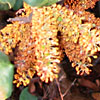Carob (Locust tree) is a green dioecious tree, with a broad crown, which reaches a height of up to 10 meters. It has a thick trunk which sometimes achieves great thickness. The bark of the woody branches is scabrous and brown-gray in color. The young stems are brown-reddish.
The leaves are pennate, arranged alternately on the stem. The leaflets are arranged opposite on the leaf axis, and sit on a short petiole. The leaflet is rounded, its margin is entire and it is broad and rigid.
The flowers are arranged in spicate inflorescences that develop in the axil of the leaves or on woody branches or on the trunk. Male and female flowers grow on separate trees. Blooming occurs from August until December-January. The main bloom is in the autumn. The base of the male flowers has 5 lobes without petals and 5 stamens that contain a large amount of pollen. The flowers emit an unpleasant and strong odor that draws insects. The female inflorescence also has no petals. The ovary is superior. It is elongated and hooked with the stigma at its apex. The ovary resembles a tiny legumen. The receptacle contains a large amount of nectar. Pollination of the flowers is by wind as well as by insects, such as ants and antlions.
After pollination, an elongated and hard legumen develops. It ripens after one year and does not open. Upon ripening, it reaches a length of 8-30 cm and a width of 1.5-2.5 cm and its color changes from green to dark brown. The seeds in the legumen are round, brown, with a very hard shell and smooth texture. The seed is called gerah (Exodus 30: 13), which is the origin for the word carat which is a unit of weight (one fifth of a gram) that still serves for the appraisal of precious stones. In antiquity, carob seeds were used as a unit of weight since they do not lose water and their weight remains constant.
In addition to the seeds, the legumen contains a sweet juice called “carob honey”. The fruit is eaten by man and animals. The seeds of the carob germinate with difficulty and the seedling grows slowly.
The origin of the carob is Mediterranean, but some claim that it originates from the mountains of Yemen. The carob is not mentioned in the Bible, but is mentioned in the Mishnah and the Talmud. There exist archeological finds that indicate the presence of carobs in Israel only since the period of the Second Temple. They are therefore thought to have entered Israel at that time. Carob trees are mentioned in the literature of travelers who passed through the Land of Israel, such as Abbot Daniel (1106) who mentions carobs in the Jerusalem area, Hebron, Tabor, and Nablus. Other travelers, such as Doubdan (1657), Pococke (1743) and Tristram (1865) mentioned the presence of carob in the Holy Land.
Carobs grow in Israel wild as well as cultivated. During the 1950s animals such as chickens and livestock were fed with a mixture that contained chopped carob legumens. Carobs were planted in a few agricultural settlements in the Sharon for this purpose. Remains of these carobs are still found there, as well as in areas around Nahal Poleg.
Ceratonia siliqua grows wild in the Mediterranean Maqui at an elevation of up to 400 meters, mainly on southern aspects, together with Pistacia lentiscus. Carobs also grow on the kurkar (aeolianite) mounds north of Netanya in a Forest-Park together with Pistacia lentiscus. Many trees near the seashore have obtained a unique shape, where most of the crown is inclined against the wind (flag-shaped). The young branches exposed to the wind are scorched by the sea salt, whereas in the rear, the branches are better protected. It is common in Israel along the seashore, in the mountains, the plain and the valleys.
Written by Erga Aloni








